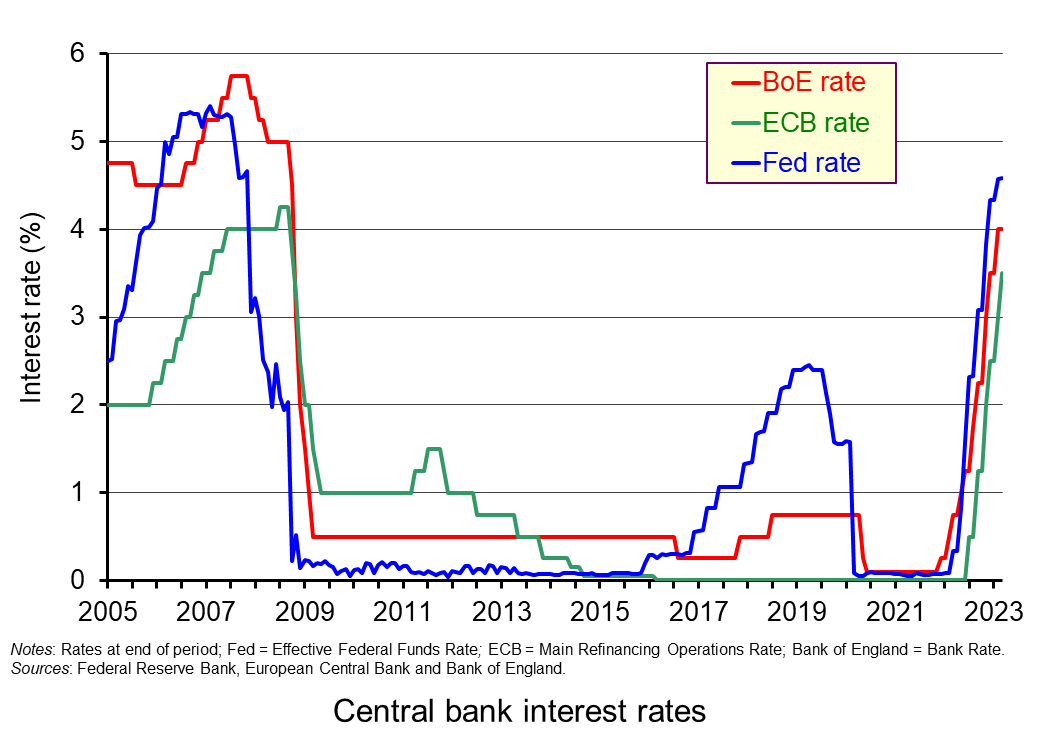 The mandates of central banks around the world are typically focused on controlling inflation. In many cases, this is accompanied by operational independence from government, but with the government setting an inflation target. The central bank then chooses the appropriate monetary policy to achieve the inflation target. This is argued to provide the conditions that can deliver lower and less variable inflation rates – at least over the longer term.
The mandates of central banks around the world are typically focused on controlling inflation. In many cases, this is accompanied by operational independence from government, but with the government setting an inflation target. The central bank then chooses the appropriate monetary policy to achieve the inflation target. This is argued to provide the conditions that can deliver lower and less variable inflation rates – at least over the longer term.
However, some economists argue that this has the potential to create the conditions for greater economic volatility and financial instability. The events surrounding the collapse of Silicon Valley Bank (SVB) – the largest since the global financial crisis – have helped to reignite these debates.
Inflation targeting central banks
The theoretical foundations for delegating monetary policy to central banks with mandates to meet an inflation rate target is often attributed to the paper of Fynn Kydland and Edward Prescott published in the Journal of Political Economy in 1977. It argues that if governments, rather than independent central banks, operate monetary policy, systemically-high inflation can become established if low-inflation announcements by governments lack credibility. Delegation of monetary to a central bank with an inflation rate target, however, can create the necessary conditions for credibility. This, in turn, gives the public confidence to maintain lower and more stable inflationary expectations than would otherwise be the case.
To mitigate the problem of a potential inflationary bias, it is argued that governments should delegate monetary policy to a conservative central banker: one that places less weight on output or employment stabilisation and more weight on inflation stabilisation than does society. However, as identified by Kenneth Rogoff in his paper published in the Quarterly Journal of Economics in 1985, this raises the spectre of greater volatility in output and employment when economies are buffeted by supply shocks.
Inflation–output stabilisation trade-off
The inflation–output stabilisation trade-off identified by Rogoff has particular relevance to the macroeconomic environment experienced by many countries in recent times. As economies began to open up after the pandemic, demand–supply imbalances saw the  emergence of inflationary pressures. These pressures were then exacerbated by the Russian invasion of Ukraine, which drove up commodity prices.
emergence of inflationary pressures. These pressures were then exacerbated by the Russian invasion of Ukraine, which drove up commodity prices.
Rather than pursuing a less contractionary policy in the face of these supply shocks so as to avoid recession, central banks stuck to their inflation mandates and hence raised interest rates significantly so as to bring inflation back to target as soon as possible. But this hampered economic recovery.
Inflation–financial stability trade-off
Yet the recent financial turmoil suggests a further inflation–stability trade-off: an inflation–financial stability trade-off. By raising interest rates, different sectors of the economy are liable to greater financial distress. This distress has contributed to the collapse of Silicon Valley Bank and Signature Bank, and led to a significant injection of funds by large US banks into First Republic. The fear is of a contagion within the financial sector, which then spills into other sectors of the economy.
The debate about central bank mandates and the weight attached to inflation stability relative to other objectives is therefore centre stage of macroeconomic policy debates.
Articles
- Inflation targeting and the 2 per cent goal
- Breaking the shackles of inflation targets
- Evaluating Monetary Policy with Inflation Bands and Horizons
- Need to rethink long-term inflation target: MPC member Ashima Goyal
- Inflation Targeting Pros and Cons
- Central banks walk tightrope in juggling mandates
- Silicon Valley Bank: why did it collapse and is this the start of a banking crisis?
- Silicon Valley Bank: Regulators take over as failure raises fears
- HSBC swoops in to rescue UK arm of Silicon Valley Bank
- Silicon Valley Bank said it was too small to need regulation. Now it’s ‘too big to fail’
- Multi-billion dollar rescue deal for First Republic Bank
- Chancellor ‘welcomes’ decision to give Credit Suisse £44.5bn lifeline as shares bounce back
Financial Times, Editorial Board (16/12/22)
The Business Standard, Daniel Moss, Bloomberg (16/3/23)
Federal Reserve Bank of San Francisco, letter, Troy Davig and Andrew Foerster (21/2/23)
The Economic Times (India) (15/3/23)
Economicshelp, Tejvan Pettinger (16/11/17)
Reuters, Mike Dolan (15/3/23)
The Guardian, Jonathan Barrett (13/3/23)
BBC News (11/3/23)
BBC News, Michael Race (13/3/19)
The Guardian, Rebecca Burns and Julia Rock (17/3/23)
BBC News, Natalie Sherman (16/3/19)
Sky News, Samuel Obsborne (16/3/23)
Questions
- Explain the argument that the delegation of monetary policy can help to keep the average rate of inflation lower.
- How might the monetary policy responses of central banks to an inflation shock create the possibility of an inflation–output stabilisation trade-off?
- What do you understand by a Taylor rule? Could this help to alleviate the inflation-output stabilisation trade-off?
- Some economists argue that there is less of a trade-off between inflation and output stability with demand-pull inflation because of a so-called ‘divine coincidence’ in monetary policy. Why might this be the case?
- What do you understand by the term ‘financial distress’? What metrics could be used to capture this for different sectors of the economy?
- Explain how financial contagion can spread both within and between different sectors of the economy.